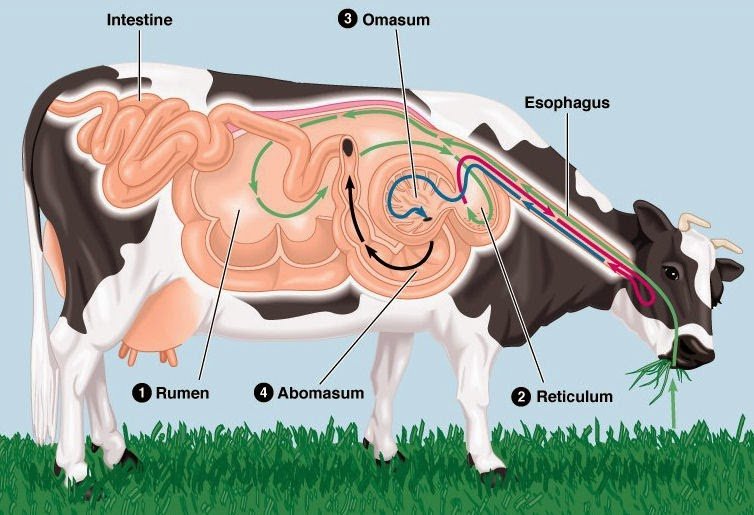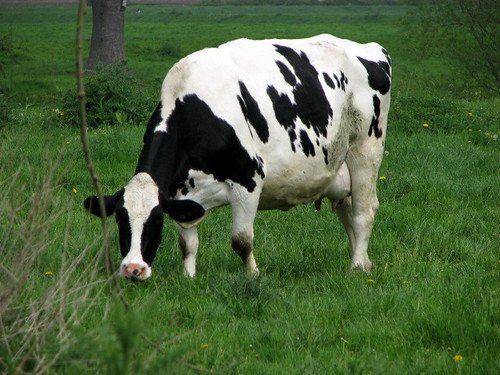Imagine if you could eat nothing but grass for your entire life and somehow transform it into rich, creamy milk and perfectly marbled beef. Sounds impossible, right? Yet every day, millions of cows around the world perform this incredible feat of biological alchemy. The secret isn’t in their hooves or their gentle eyes – it’s hidden deep within their bellies, where trillions of microscopic workers toil away in one of nature’s most sophisticated biochemical factories.
The Four-Chambered Universe

When you think about a cow’s stomach, you might picture a simple pouch like your own. But here’s where things get fascinating – cows don’t have just one stomach, they have four distinct chambers that work together like a perfectly orchestrated assembly line. The rumen, reticulum, omasum, and abomasum each play unique roles in breaking down that seemingly indigestible grass.
The rumen alone can hold up to 50 gallons of fermenting plant material, making it roughly the size of a garbage can. Picture that massive fermentation vat sitting inside a cow, churning and bubbling with activity 24 hours a day. It’s like having a brewery, a compost pile, and a chemical plant all rolled into one incredible biological system.
Meet the Microscopic Workers

Inside that rumen lives a bustling metropolis of microorganisms so diverse it puts any major city to shame. Scientists have identified over 200 different species of bacteria, along with protozoa, fungi, and even viruses, all working together in perfect harmony. These tiny creatures number in the trillions – that’s more individual organisms than there are stars in our galaxy.
Think of these microbes as the ultimate recycling team. They take tough, fibrous plant material that would pass right through your digestive system and transform it into volatile fatty acids that the cow can actually use for energy. It’s like having a personal army of molecular chefs who can turn sawdust into a gourmet meal.
The Cellulose Breakthrough

Here’s something that might blow your mind: humans can’t digest cellulose at all. That’s why we can’t survive on grass like cows can. Cellulose is essentially nature’s version of reinforced concrete – it’s what gives plants their structure and strength. But the bacteria in a cow’s rumen produce special enzymes called cellulases that can break down these tough molecular chains.
This process is so efficient that cows can extract energy from materials that would be completely worthless to most other animals. It’s like having a key that can unlock a treasure chest that everyone else walks right past. The microbes literally tear apart the cellulose molecule by molecule, releasing sugars that can then be fermented into usable energy.
The Fermentation Factory

The rumen operates like a massive fermentation tank, maintaining perfect conditions for its microbial residents. The temperature stays consistently around 102°F, the pH remains slightly acidic, and there’s no oxygen – creating an anaerobic environment where these special bacteria thrive. It’s more precisely controlled than most industrial fermentation facilities.
This fermentation process produces an impressive array of products. The main outputs are volatile fatty acids like acetate, propionate, and butyrate, which provide about 70% of the cow’s energy needs. But that’s not all – the process also produces methane gas, carbon dioxide, and even B vitamins that the cow’s body requires.
The Protein Paradox

Here’s where things get really interesting: cows can actually make high-quality protein from non-protein sources. The microbes in their rumen can take simple nitrogen compounds and transform them into amino acids, the building blocks of protein. It’s like having a molecular construction crew that can build a skyscraper from a pile of basic materials.
This ability means cows can thrive on low-protein feeds that would never sustain other animals. The bacteria themselves become a protein source when they die and get digested further down the digestive tract. It’s a brilliant biological recycling system where even the workers become part of the final product.
The Chewing Championship

You’ve probably noticed cows seem to chew constantly, even when they’re not eating. This behavior, called rumination or “chewing cud,” is actually a crucial part of their digestive strategy. Cows regurgitate partially digested food from their rumen and chew it again, breaking it down into smaller pieces that the microbes can work on more effectively.
A single cow can spend up to 8 hours a day just chewing, producing up to 40,000 jaw movements daily. That’s more repetitive motion than most factory workers perform. This mechanical breakdown dramatically increases the surface area available for microbial attack, making the whole system far more efficient.
The Methane Dilemma

Not everything about this microbial magic is perfect for our planet. The fermentation process in cow rumens produces significant amounts of methane, a potent greenhouse gas. A single cow can produce 250 to 500 liters of methane per day – that’s enough to fill several large balloons.
This methane production represents a fascinating biological trade-off. The same processes that allow cows to thrive on grass also contribute to climate change. Scientists are now working on ways to modify the rumen microbiome to reduce methane production without harming the cow’s health or productivity.
The Vitamin Factory

The microbes in a cow’s rumen don’t just break down food – they also manufacture essential nutrients. These tiny organisms produce B vitamins, including B12, folate, and biotin, that the cow couldn’t get from grass alone. It’s like having a pharmaceutical factory built right into the digestive system.
This vitamin production is so efficient that cows never need vitamin supplements the way many other animals do. The microbes essentially pay rent for their luxurious rumen accommodations by providing these essential nutrients. It’s a perfect example of mutualism – both the cow and the microbes benefit from their partnership.
The pH Balancing Act

Maintaining the right pH in the rumen is like walking a tightrope. Too acidic, and the beneficial bacteria die off. Too basic, and the fermentation process slows down dramatically. The cow’s body has evolved sophisticated mechanisms to keep this delicate balance, including producing up to 200 liters of saliva per day to buffer the acid.
When this balance gets disrupted – often from eating too much grain – it can lead to acidosis, a serious condition that can harm both the microbes and the cow. It’s a reminder that this ancient partnership between cow and microbe evolved around grass, not the high-energy feeds we sometimes give cattle today.
The Immune System Partnership

The relationship between cows and their rumen microbes goes beyond just digestion. These microorganisms actually help train and support the cow’s immune system. They produce compounds that help fight off harmful bacteria and even contribute to the cow’s overall health and disease resistance.
This microbial partnership is so important that calves are born with sterile rumens and must acquire their microbes from their environment, usually from their mothers. It’s like passing down a family recipe that’s been perfected over millions of years of evolution.
The Temperature Control System

The fermentation in a cow’s rumen generates significant heat – so much that it actually helps keep the cow warm in cold weather. This internal heating system is so efficient that cows can maintain their body temperature even in surprisingly cold conditions. It’s like having a built-in furnace that runs on grass.
During hot weather, this heat production can become a challenge, requiring cows to find ways to dissipate the excess thermal energy. The constant internal heat generation is one reason why cows often seek shade and water during the hottest parts of the day.
The Antibiotic Sensitivity

The delicate microbial ecosystem in a cow’s rumen can be dramatically disrupted by antibiotics. These medications, designed to kill harmful bacteria, can also devastate the beneficial microbes that cows depend on for digestion. It’s like dropping a bomb on a thriving city – the collateral damage can be enormous.
When the rumen microbiome is disrupted, cows may experience digestive problems, reduced feed efficiency, and even serious health issues. This is why veterinarians are increasingly careful about antibiotic use in cattle, recognizing that these medications can have far-reaching effects on the cow’s internal ecosystem.
The Adaptation Marvel

The rumen microbiome isn’t fixed – it can actually adapt to different diets over time. When cows switch from grass to grain, or from one type of forage to another, the microbial population gradually shifts to optimize digestion of the new feed. It’s like having a workforce that can retrain itself for different jobs.
This adaptability is remarkable, but it takes time – usually several weeks for the microbiome to fully adjust to a new diet. Rush the process, and the delicate balance can be disrupted, leading to digestive problems. It’s a reminder that even the most sophisticated biological systems have their limits.
The Efficiency Engineers

When you look at the numbers, the efficiency of the cow’s microbial partners is truly staggering. They can convert up to 70% of the cellulose in grass into usable energy for the cow. Compare that to industrial cellulose processing, which is still struggling to achieve similar efficiency rates despite decades of research and development.
This biological efficiency has caught the attention of biotechnology companies trying to develop better ways to convert plant waste into biofuels. Nature’s solution, perfected over millions of years, remains superior to our best engineering efforts. Sometimes the old ways really are the best ways.
The Future of Rumen Research

Scientists are now using advanced genetic sequencing techniques to map the entire rumen microbiome in unprecedented detail. This research is revealing new species of bacteria and uncovering complex interactions that we never knew existed. It’s like discovering a hidden civilization that was there all along.
This knowledge could revolutionize livestock nutrition, help develop new probiotics for cattle, and even inspire new approaches to renewable energy production. The humble cow’s stomach might just hold keys to solving some of our most pressing environmental and energy challenges.
The Probiotic Potential

Just as humans are learning about the importance of gut health, farmers are beginning to appreciate the value of supporting their cattle’s microbial partners. Probiotic supplements designed specifically for cattle are becoming more common, helping maintain healthy rumen function and improve overall animal health.
These targeted probiotics can help cattle recover from digestive upsets, improve feed efficiency, and even reduce methane production. It’s a practical application of our growing understanding of the vital role these microscopic partners play in cattle health and productivity.
The next time you see a cow peacefully grazing in a field, remember that you’re witnessing one of nature’s most sophisticated biotechnology demonstrations. Inside that seemingly simple animal is a microscopic universe of cooperation, efficiency, and biological innovation that puts our best technology to shame. These tiny partners have been quietly revolutionizing agriculture for millions of years, turning grass into the building blocks of life itself.
What other secrets might be hiding in plain sight, waiting for us to discover the incredible complexity behind life’s most basic processes?




